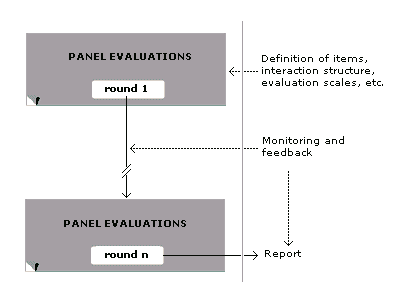4.1 Expertní metoda použitá pro sběr dat
Expertní metoda resp. metody dle [86] využívají znalosti a praktické zkušenosti expertů v příslušném oboru k získání: odhadů neměřitelných veličin, odhadů údajů, které nejsou k dispozici a jejichž získání by bylo neúměrně náročně, odhadů budoucího vývoje (stavu), návrhu tvůrčích řešení, apod. Typickým využitím expertů jsou v uvedené množině metod úzké specializované problémy, anebo zejména obecné, složité a komplexní problémy (tj. složitě a špatně strukturované, slabě formalizované, jedinečné a neopakovatelné, s nedostatkem či úplnou absencí objektivní kvalitativní informace, apod.) [86]. Expertní šetření probíhalo v následujících fázích:
- Výběr expertů.
- Získání expertních výpovědí.
- Vyhodnocení expertních výpovědí.
Kvalita výběru expertů přímo ovlivňuje kvalitu získaných výsledků analýzy. Rozhodujícími vlivy jsou počet expertů (tj. pro statistickou významnost získaných výsledků) a jejich relevantní vlastnosti (např. kompetentnost, kreativita, vztah k tématu, konformita, analytické myšlení a šíře myšlení, konstruktivnost, sebekritičnost, tolerance) [86]. Určení počtu expertů a výběr vhodných vlastností jsou parametry závislé na výběru metody pro získání expertních výpovědí a zároveň tímto ovlivňují náklady na analýzu, tj. finanční i časové.
Získání expertních výpovědí může probíhat více způsoby, a to dle [86] podle: způsobu komunikace organizátorů s experty, úrovně komunikace mezi experty během expertního šetření, opakovanosti zjišťování informací, stupně standardizace.
Pro účely disertační práce byla zvolena vícestupňová metoda Delphi.
4.1.1 Vícestupňová metoda Delphi
Uvedená vícestupňová metoda Delphi [23,86] 1 je metodou získání expertních výpovědí s následujícími vlastnostmi [86]:
- více kolové anketní šetření se zpětnou vazbou,
- dochází k systematickému zpřesňování názoru skupiny expertů,
- anonymita expertů,
- zpětná vazba informací,
- experti mají před dalším kolem k dispozici skupinový názor i netypické názory,
- možnost přihlížet k okolnostem, které si expert dříve neuvědomoval, resp. možnost přehodnocení netypického názoru,
- pokud expert trvá na netypickém názoru, musí jej odůvodnit.
Získání výpovědí probíhá ve více kolech, ve kterých dochází k postupnému upřesňování posledních výsledků. Ukončení metody nastává při dosažení “shody” expertů, nebo je-li dosaženo stability individuálních výpovědí [86]. Nevýhodou metody Delphi je její časová náročnost a vyšší pracnost zpracování otázek se zacílením k požadovaným výsledkům, zpracování anketních dotazníků a interpretace výsledků pro jejich doplnění v dalším kole, resp. stupni odpovědí.
Vyhodnocení expertních výpovědí probíhá dle [86] ve dvou fázích: určení skupinového názoru, a posouzení kvality získaných informací. Určení skupinového názoru lze provést pomocí kvantitativních (aritmetický průměr, modus nebo medián, rozdělení, statistické charakteristiky – rozptyl, kvantilové rozpětí, intervalové odhady, charakteristiky rozdělení) nebo kvalitativních odhadů (nominální stupnice, převod na bodovou kvantitativní stupnici, formalizace a kvantifikace odpovědí).

4.1.2 Využití metody Delphi pro bezpečnostní výzkum provozu metra
Cílem výzkumu provedeného ve spolupráci se zaměstnanci Dopravního podniku hl. m. Prahy bylo ověření metod pro hodnocení kritické infrastruktury a určení kritičností prvků systému. Výzkum probíhal formou expertního šetření. Každý expert byl dotazován pomocí elektronického formuláře [5,16], k jeho vyplnění byl dotázán e-mailem.
Skupina expertů byla volena na základě referencí od vybraných zaměstnanců provozovatele metra a od vybraných poskytovatelů služeb a dodavatelů klíčových zařízení potřebných pro provoz metra. Každý, takto oslovený expert měl možnost doporučit další vhodné experty v následujících oblastech: bezpečnost práce a ochrana zdraví personálu, ochrana majetku, ekonomika provozu, ochrana cestujících, technická a funkční bezpečnost provozu.
Podmínkou pro doporučení experta do expertního týmu byla jeho dlouholetá znalost provozu metra s praxí v různých oblastech uvedených výše a na různých úrovní řízení, tj.: strategické řízení, taktické a projektové řízení, operativní řízení, technický pracovník, technické práce.
Celkem bylo osloveno 18 expertů, kteří byli před zahájením šetření požádáni o vyplnění krátkého dotazníku pro určení kvalifikace experta dle [86].
Dotazování metodou Delphi bylo členěno celkem do 3 fází:
- Identifikace aktiv (funkce, místa a části systému metra, která jsou důležitá pro jeho bezpečný provoz).
- Určení důležitosti a zranitelnosti.
- Scénáře dopadů vybraných pohrom.
Po skončení každého kola dotazování byly výsledky vyhodnocené, a v případě neshod se provedlo upřesnění a odůvodnění, které probíhalo i v několika iteracích. Průběh šetření a jednotlivé otázky pro každé kolo jsou uvedené v příloze A.
4.1.3 Použité stupnice
V uvedeném bezpečnostním výzkumu a v předložené disertační práci pracujeme s kritičností K, jakožto funkce důležitosti D a zranitelnosti Z, v souladu s definicí v odstavci 2.1.3:
K = D x Z
(21)
Uvedené veličiny jsou závislé na tom, v jaké úrovni systému řízení bezpečnosti danou veličinu posuzujeme, tj. dle přístupu Defence-In-Depth (odstavec 2.1.7 a 2.3.4) a podle zdroje [18] sledujeme následující úrovně (podrobnější popis úrovní pro účely předmětného výzkumu je v příloze A):
- Bezpečný provoz metra za normálních podmínek (úroveň řízení L1).
- Bezpečný provoz metra za abnormálních podmínek (úroveň řízení L2).
- Bezpečný provoz metra při větších odchylkách / zvládání havárií
(úroveň řízení L3). - Řízení provozu a aktiv metra v případě kritických podmínek
(úroveň řízení L4). - Řízení provozu a aktiv metra v případě extrémních podmínek
(úroveň řízení L5).
Pro veličiny D a Z byly použité ordinální škály, tj. stupnice v rozmezí 1 až 3, se zvážením kritérií pro kritickou infrastrukturu [34,35]. Popis každé číselné hodnoty je uveden v odstavci A.2.1 přílohy A.
Rozdělení pohrom do kategorií relevantní, specifické a kritické dle přístupu All-Hazard-Approach (odstavec 2.1.2 a 2.1.7).



